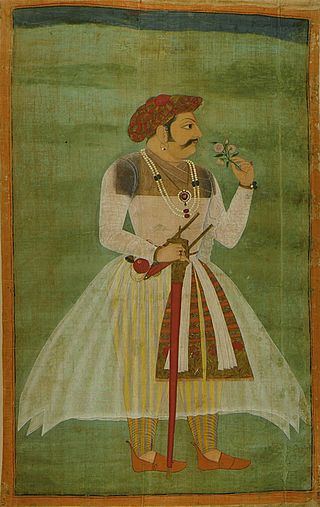Top Qs
Timeline
Chat
Perspective
Jagat Singh I
Maharana of Mewar from 1628 to 1652 From Wikipedia, the free encyclopedia
Remove ads
Maharana Jagat Singh I[1] (1607 – 10 April 1652), was a Sisodia Rajput ruler of Mewar Kingdom (r. 1628–1652).[2]
This article needs additional citations for verification. (August 2021) |
Remove ads
Biography
Summarize
Perspective
Jagat Singh succeeded his father, Karan Singh II, as the ruler of Mewar. By the time he ascended the throne, the state had recovered enough from previous conflicts that he sought to expand Mewar’s influence over neighboring territories. During decades of warfare, Mewar had lost significant areas, and regions such as Mandalgarh, Banera, Shahpura, Dungarpur, and Banswara had become effectively autonomous, governed by local chiefs holding these lands as jagirs from the Mughal emperor.[3]
In an effort to reclaim lost territories, Jagat Singh launched military campaigns around 1635 against neighboring states including Pratapgarh-Deoliya, Dungarpur, Sirohi, and Banswara. During these conflicts, the ruler of Deoli, Jaswant Singh, was killed, leading his successor to appeal for Mughal intervention. Jagat Singh also began repairs on the fort of Chittor, an act that breached the terms of the 1615 Mewar-Mughal treaty. Although the Mughal emperor Shah Jahan initially overlooked this due to his long-standing association with the family—dating back to Shah Jahan's youth as Prince Khurram—he eventually responded in 1643 by sending an army under Sadullah Khan. Through negotiations, Jagat Singh was able to placate the emperor.[4]
Jagat Singh is also remembered for his patronage of learning and the arts. His reign witnessed the construction of Udaipur’s famous Jagdish (Jagannath Rai) temple and the completion of the Jagmandir palace, where Shah Jahan had once stayed. An important inscription from 1652, composed by Lakshmi Nath and displayed at the Udaipur temple, provides insight into the contemporary rituals and significant events of the period. The later years of his reign were marked by economic prosperity, as evidenced by the regular ‘tula-daan’ ceremonies in which he was weighed in silver and later in gold, with the corresponding weight given away in charity to Brahmins and the needy.[5] He died in October 1652, and was succeeded by his son, Raj Singh I.
Remove ads
References
Wikiwand - on
Seamless Wikipedia browsing. On steroids.
Remove ads

